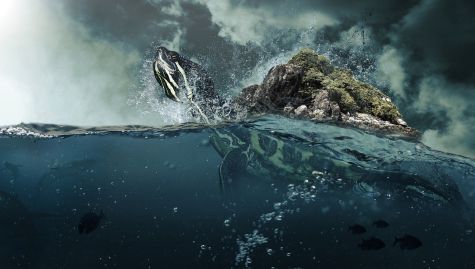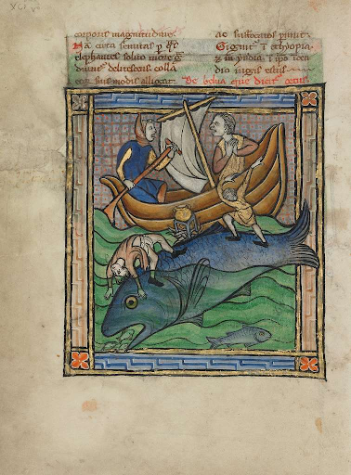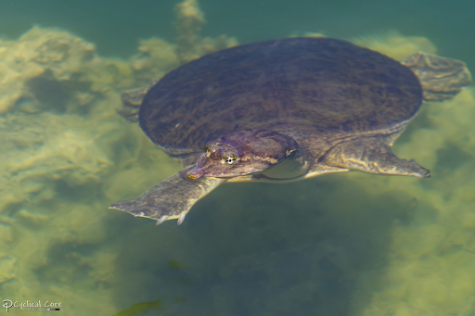Mysteries, Oddities, and Everything Strange: Aspidochelone
May 31, 2022
Aspidochelone: A Really Giant Turtle
Islands are pretty spectacular. Small floating pieces of rock and shrubbery that can be vacation destinations or entire sovereign nations. They’re scattered throughout the ocean in random patterns and exist in all shapes and sizes. Some argue that continents are technically islands, but that’s a thought for another day. But an undeniable fact is that these hunks of rock literally don’t move. They stay in place, rooted to the ground by formations made millions of years ago. But legends might say otherwise, especially the stories of the aspidochelone, a big name for a pretty big turtle.
 The name, in all its length, is a combination of two Greek words. The first part, aspis, means “shield” and the second part, chelone, “means turtle.” So, evidently, aspidochelone means “shielded turtle.” Some legends describe the aspidochelone as a giant whale, but most have placed emphasis on its turtle-like qualities. No matter what it looks like, it is described as having an ecosystem on its back, with trees, shrubs, sand, and naturally occurring phenomena. The stories would tell of the aspidochelone rising to the surface and appearing as an enticing landform for sailors at sea. The sailors would dock and then step onto the turtle’s back, only to be brought to the bottom of the sea and drown.
The name, in all its length, is a combination of two Greek words. The first part, aspis, means “shield” and the second part, chelone, “means turtle.” So, evidently, aspidochelone means “shielded turtle.” Some legends describe the aspidochelone as a giant whale, but most have placed emphasis on its turtle-like qualities. No matter what it looks like, it is described as having an ecosystem on its back, with trees, shrubs, sand, and naturally occurring phenomena. The stories would tell of the aspidochelone rising to the surface and appearing as an enticing landform for sailors at sea. The sailors would dock and then step onto the turtle’s back, only to be brought to the bottom of the sea and drown.
The aspidochelone has been featured in many old books, some religious, that describe it and tell its haunting stories. Some of them compare the turtle to the devil himself, and it is meant to lure his supposed victims to the bottom of the ocean. An Old English poem, known as “The Whale,” has gone through many different versions and translations, but its modern English version still tells the tale of the aspidochelon and what it does to such sailors. In fact, Lord of the Rings author J. R. R. Tolkein even took inspiration from the work to write his own poem about what he called the Fastitocalon.
 The main origin of the myth comes from Saint Isidore of Seville in Spain in the 7th century. He wrote a book, Etymologiae, and in it he describes monsters with mountain-like bodies in shape and size. He gave them a name sourced from the Greek word ballein, meaning emit, describing how they emitted water as they breached the surface from the depths of the ocean. A long time later, in the 13th century, Guillaume de Clerc and Bartholomaeus Anglicus both authored books that furthered the legend of the aspidochelone, warning possible sailors of the dangers that could come with it. Anglicus even described it as quite possibly the most horrible, evil, dangerous thing alive and a massive body that was too massive to be accurately represented.
The main origin of the myth comes from Saint Isidore of Seville in Spain in the 7th century. He wrote a book, Etymologiae, and in it he describes monsters with mountain-like bodies in shape and size. He gave them a name sourced from the Greek word ballein, meaning emit, describing how they emitted water as they breached the surface from the depths of the ocean. A long time later, in the 13th century, Guillaume de Clerc and Bartholomaeus Anglicus both authored books that furthered the legend of the aspidochelone, warning possible sailors of the dangers that could come with it. Anglicus even described it as quite possibly the most horrible, evil, dangerous thing alive and a massive body that was too massive to be accurately represented.
One of the most famous representations of the aspidochelone comes from The Legend of Saint Brendan, where it was known as Jasconius. Saint Brendan and his fellow sailors land on one of these sleeping beasts, celebrating the holiday of Easter while atop it. Much to their dismay, they light a fire, which awakens the creature. Thankfully, they were able to flee back to their ship before it sank. The exact same version of the aspidochelone appears in The Book of One Thousand and One Nights, the story of Sinbad the Sailor. Greenland mythology called it the Imap Umassoursa, but it was said to tip over, making unsuspecting sailors slide into freezing water and eventually freeze. It is also featured in Miguel Palacios’ Book of Animals and Al Qaswini’s Wonders of Creation.
These legends are spread out everywhere throughout the world, and one such legend from Chile also stands out. It originated before Christopher Columbus’ time and was known as Cuero or Hide. It appeared as a stretched out animal and was extremely similar to the tales that originated from Europe and the Middle East, which was strange because of its disconnect from that part of the world at the time.
out. It originated before Christopher Columbus’ time and was known as Cuero or Hide. It appeared as a stretched out animal and was extremely similar to the tales that originated from Europe and the Middle East, which was strange because of its disconnect from that part of the world at the time.
Very similar tales from contrasting parts of the world can’t be a coincidence. From South America to Asia, the tale of the aspidochelone is extremely similar down to the small details. It has also made its fair share of appearances in pop culture, like its cameo in The Legend of Zelda: Majora’s Mask and the Japanese manga Naruto. In the cartoon Avatar: The Last Airbender, it is a major plot device that helps the main character work his way towards the end of the story. The aspidochelone has been a classic tale for hundreds of years, and its significance in various cultures is undeniable. I doubt anyone reading this is a sailor, but if you happen to encounter a suspicious floating island while out at sea, it might be good to investigate before you dock so that you don’t end up being sunk to the bottom of the ocean.
Resources:
https://en.wikipedia.org/wiki/Aspidochelone
https://www.getty.edu/education/kids_families/do_at_home/artscoops/sea_creature.html














































